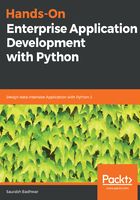
Python in the enterprise ecosystem
Python has been present in the enterprise ecosystem in quite a few forms; be it the automation of boring and repetitive tasks, being used as a glue between two layers of a product, or being used for building quick and easy-to-use clients for big server backends, the language has seen an increasing amount of adoption for various use cases. But what makes Python ready for the development of large enterprise applications? Let's take a look:
Ability to build quick prototypes: The syntax of Python is very simple, and a lot of things can be achieved with very few lines of code. This allows developers to quickly develop and iterate over the prototypes of an application. In addition to this, these prototypes do not always need to be thrown away, and if the development is properly planned, they can act as a good base to build the final application upon.
With the ability to quickly prototype an application, an enterprise software developer can see exactly how the requirements align in the application and how the application is performing. With this information, the stakeholders of the application can more accurately define the path for the application development, thereby avoiding midcycle architectural changes because something didn't work out the way it was expected to.A mature ecosystem: The mature ecosystem is one of the features of Python that deserve a lot of attention. The number of external libraries in Python has been growing at a rapid pace. For most of the tasks that need to be achieved in an application, such as two-factor authentication, testing code, running production web servers, integrating with message buses, and so on, you can easily look for a library with quite decent support.
This proves to be of great help, since it reduces the amount of code duplication and increases the reusability of the components. With the help of tools such as pip, it is very easy to get the required library added to your project, and with the support of tools such as virtualenv, you can easily segregate a lot of different projects on the same system without creating a dependency mess.
For example, if someone wants to build a simple web application, they can probably just use Flask, which is a microframework for developing web applications, and go ahead with the development of the web application without having to worry about the underlying complexities of dealing with the sockets, manipulating data on them. All they will require is a few lines of code to get a simple application up and running, as shown in the following code:
from flask import Flask
app = Flask(__name__)
@app.route('/', methods=["GET"])
def hello():
return "Hello, this is a simple Flask application"
if name == '__main__':
app.run(host='127.0.0.1', port=5000)
Now, as soon as someone calls the preceding script, they will have a flask HTTP application up and running. All that remains to be done here is to fire up a browser and navigate to http://localhost:5000. Then we will see Flask serving a web application without any sweat. All of this is made possible in under 10 lines of code.
With a lot of external libraries providing support for a lot of tasks, an enterprise developer can easily enable support for new features in the application without having to write everything from scratch, thereby reducing the chance of possible bugs and non-standardized interfaces creeping into the application.
- Community Support: The Python language is not owned by any particular corporate entity, and is completely supported by a huge community backing that decides the future of the standard. This ensures that the language will continue to see support for quite a long time, and won't become obsolete any time soon. This is of great importance to organizations, since they want long-term support for the applications they run.
Given all of the preceding benefits of Python, developer productivity will get a boost when using the language while also reducing the total cost of ownership for the software if decisions are made in a well-planned way. These decisions involve how the application architecture will be laid out and which external libraries to use or to develop in-house. So yes, Python is indeed now ready to be used in the mainstream world of enterprise application development.